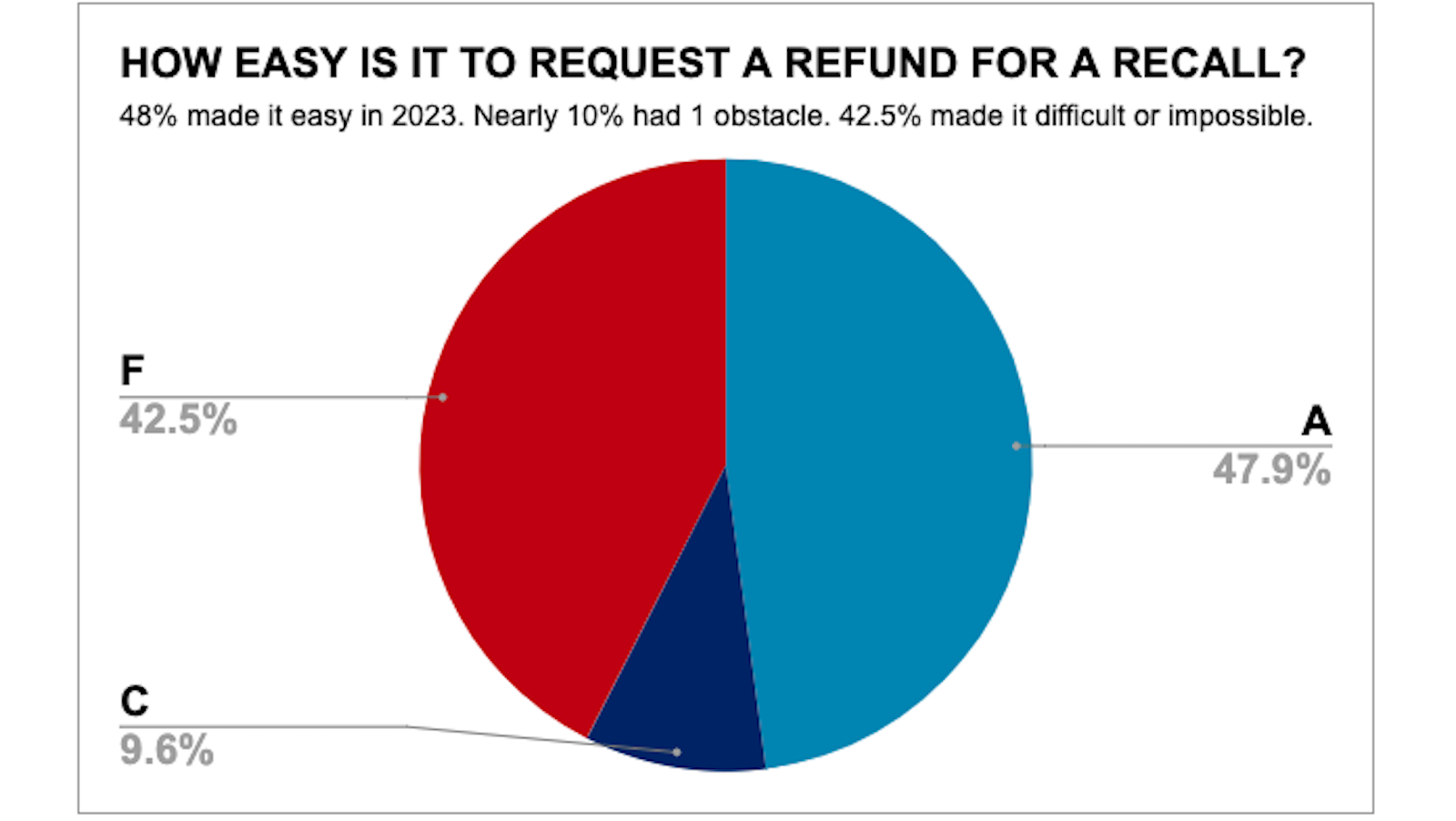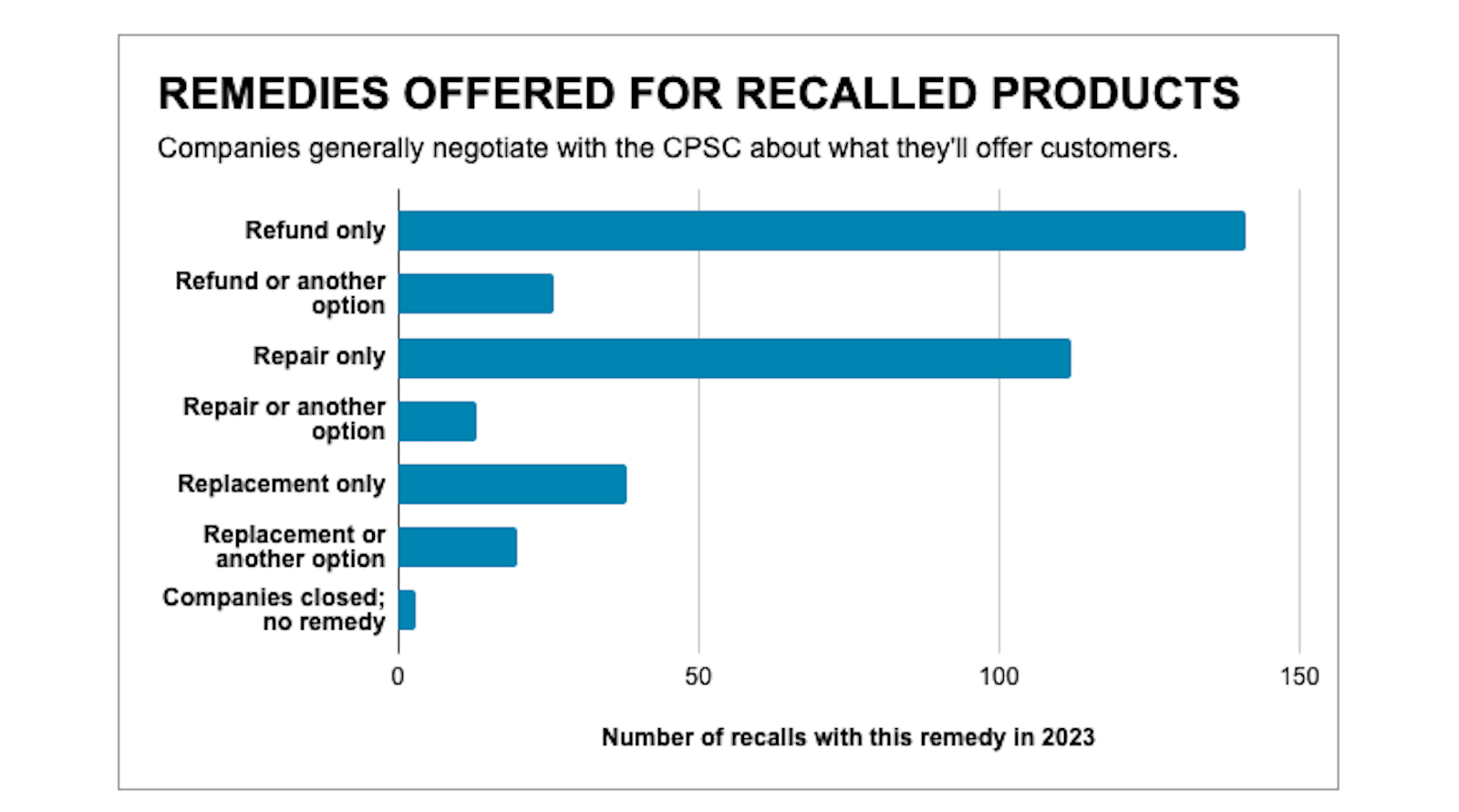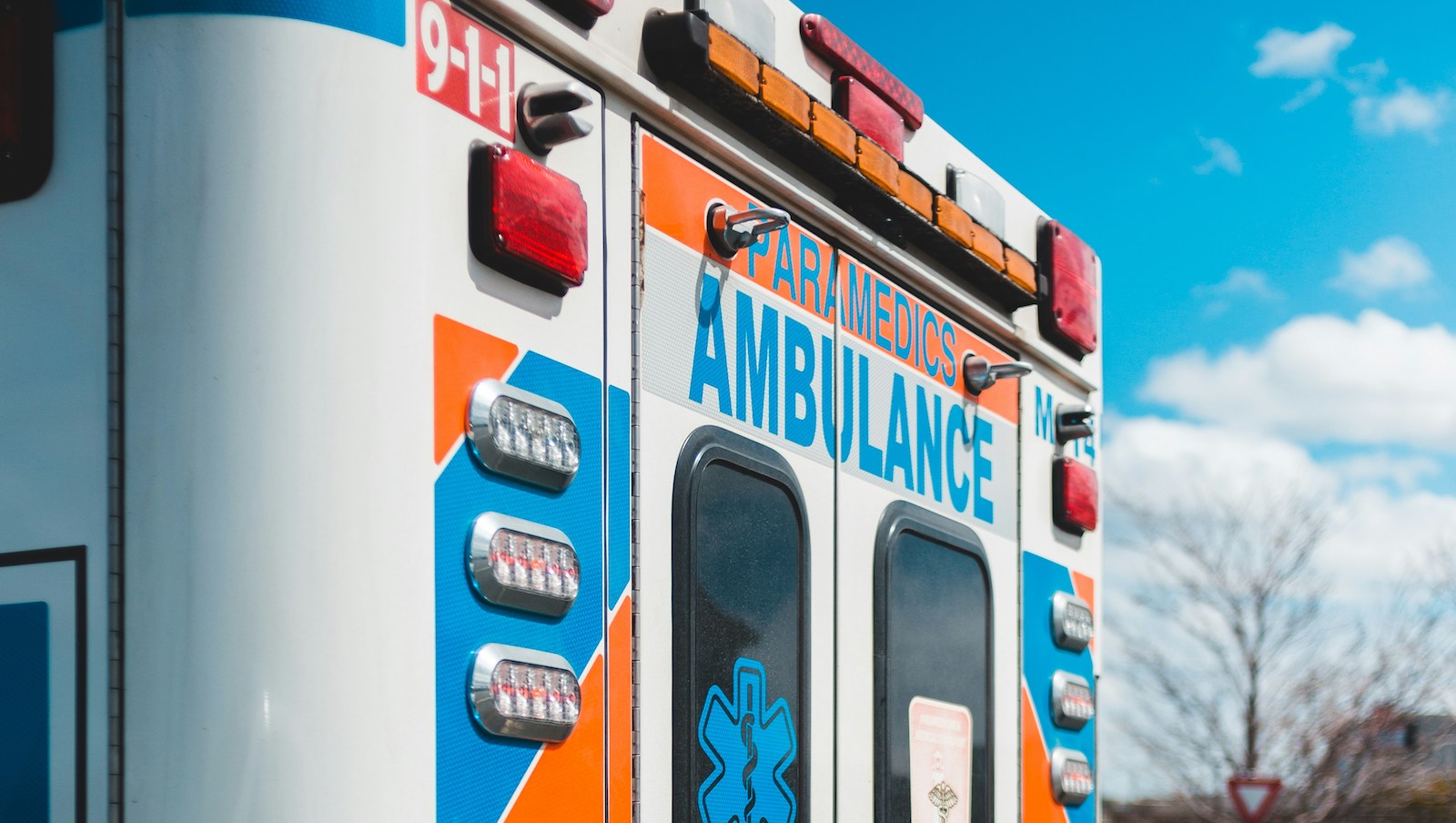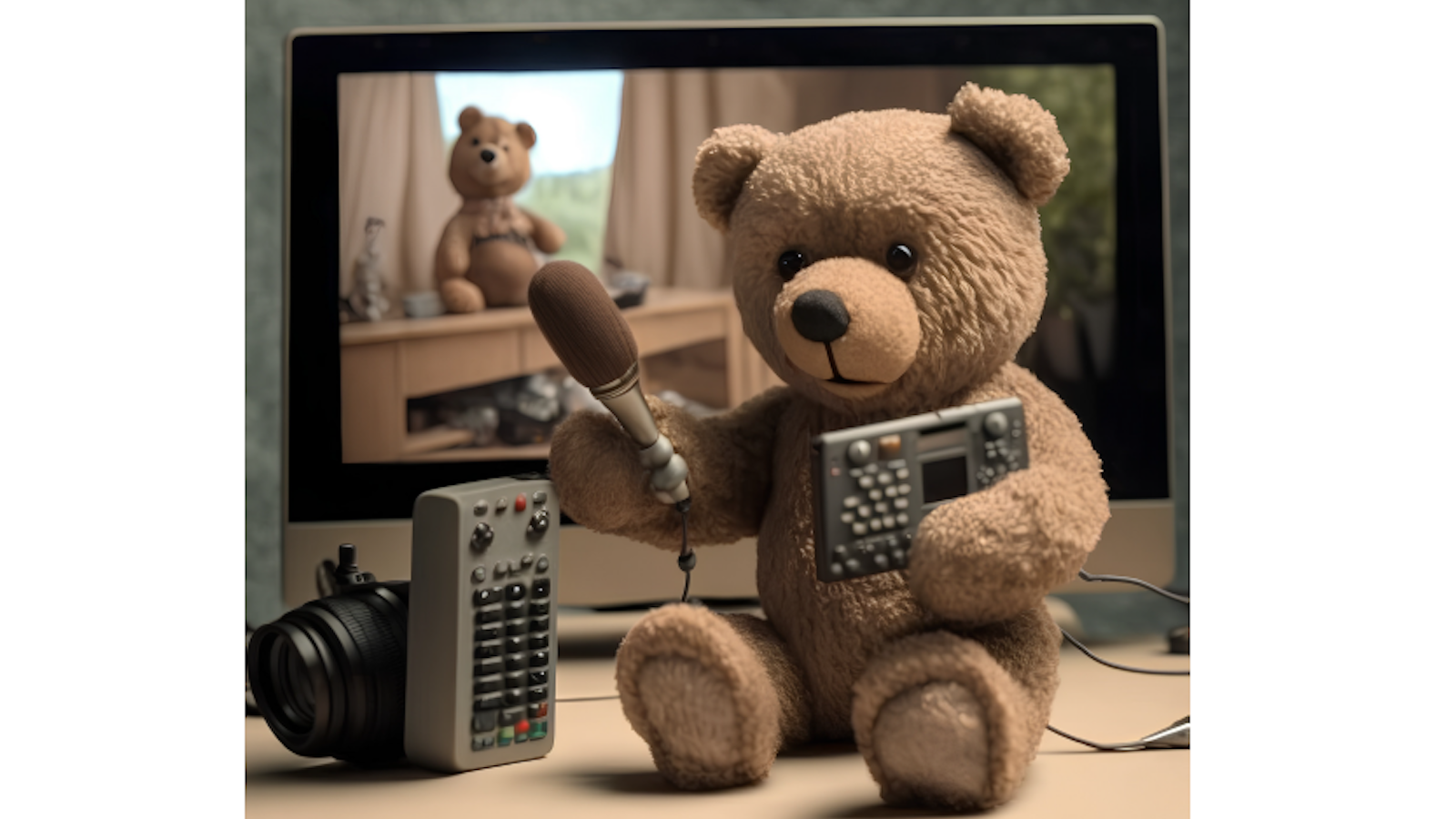
Too much to recall
When companies recall dangerous products, getting a refund or repair can be easy, or way too complicated

VIEW THE FULL REPORT
You find out your air fryer or power tool or child’s bicycle is dangerous and has been recalled. You’re told you just need to contact the company for a refund or replacement. Easy, right?
In many, many cases, not so much. Quite the opposite.
Last year, 323 consumer products were recalled in coordination with the Consumer Product Safety Commission (CPSC). More than half of recalls that offer refunds make consumers jump through unnecessary, time- consuming hoops to get their money back, an analysis by U.S. PIRG Education Fund shows.
In some cases, companies say they’ll issue full refunds of $2 or $3 – only to customers who ship the product back or physically return it to a store. In other cases, customers must register their product online and then wait for further instructions to get a low- dollar refund. In some cases, companies won’t issue actual refunds – only credits or vouchers toward another purchase.
At the other end of the spectrum, many companies will provide refunds of $200 or more without the return of an item. They require only a photo of the item rendered useless and a few other details, but they don’t necessarily require a receipt.
The CPSC published 323 recall notices from Jan. 1, 2023 through Dec. 31, 2023, from companies ranging from Amazon to Ikea to T.J. Maxx. Of those, roughly half offered refunds or the option of a refund, while the other half offered only replacements or repairs, the U.S PIRG Education Fund analysis shows. In fewer than 10% of recalls, companies offered customers a choice of remedies, usually between a refund and a replacement or repair.
We analyzed the ease of getting a refund by four main criteria:
- Can the refund be obtained with an online request or does it require a phone call (most likely during certain business hours) or an in-person visit?
- Can the refund process be completed online in one sitting, or does it require multiple cumbersome steps – you have to email some information and then get a form to fill out or print out a shipping label to return the item?
- Can you submit a photo of the product or proof of purchase, or do you have to ship the product back, return it in person or arrange to have it picked up?
- Do you get a refund by check or prepaid debit card, or does the company offer only a partial refund or credit toward a future purchase?
We found that more than half of those offering refunds – 87 of them – required one or more tasks that could make actually getting a refund difficult, such as sending an email and then waiting for a phone call, requesting a prepaid shipping label to return an inexpensive defective item or being required to actually take a dangerous product back to the store to get your money back.
The obstacles consumers face getting refunds is an important topic because it’s one of the reasons that so few consumers follow through with recalls. It’s estimated that only 6 to 10 percent of recalled products are returned or discarded.
Why? In some cases, consumers never find out a product they own has been recalled. In other cases, they may not care. And in still others, consumers don’t bother because they figure it will be too big of a hassle to request a refund or replacement. And they’re often right.
That’s what this analysis focuses on.
Burdensome recall processes have been a problem for many years. The outrage accelerated in 2019 after Fisher-Price recalled 4.7 million Rock ‘n Play Sleepers after 30 infant deaths were connected to the inclined sleeper. Fisher-Price offered refunds only to customers who’d purchased the product within the last six months if they sent pieces of the sleeper and proof of purchase. Families with products older than six months were given vouchers to use toward buying another Fisher-Price product. The sleepers cost $40 to $149. Consumers, advocates and policy-makers found the vouchers offensive and insensitive, considering the sleepers were linked to infant deaths.
For a variety of reasons, the number of sleepers returned was astonishingly low. The belief was that at least some consumers didn’t want the hassle of returning the sleepers, only to get a voucher for another product. Because of the low return numbers, the recall was reannounced in January 2023. By that time, an additional 70 infant deaths were connected to the Fisher-Price sleepers, for a total of about 100. That included at least eight deaths that happened after the April 2019 recall.
All of these types of inclined sleep products are now banned under the Safe Sleep for Babies Act, passed by Congress in 2022.
To be sure, the critical issue with all recalls is making sure consumers discard the product or get it repaired according to the recall requirements to make it safe. Still, consumers deserve a refund if a product can no longer be used safely – whether they paid $2 or $20 or $200. The process should be easier and more fair.
Companies should stop with the frustrating, unnecessary obstacles, the CPSC should try harder to negotiate better terms for consumers, and Congress should mandate easy recall requests to help keep consumers safe and not harmed financially just because they bought a product that was later recalled.

WHAT WE FOUND
Virtually all recalls announced by the Consumer Product Safety Commission are voluntary by the company. Dangerous products are usually identified in one of three ways:
- The company identifies a defect through its own testing or monitoring after a product is offered for sale.
- Consumers complain to the company.
- CPSC staff investigate incidents reported by consumers, doctors, fire officials or others on SaferProducts.gov. CPSC staff also review death certificates and other records to spot possible problems.
After the need for a recall is determined, the CPSC contacts and works with the company to decide what type of remedy is best: a repair, replacement or refund. The CPSC often has to negotiate this, which can take months, particularly if products related to an injury or property damage have been destroyed or discarded.
For example, say with an appliance, the company may propose a repair as an easy, fairly inexpensive option for the company, but the CPSC must determine whether the new part or repair actually solves the problem and doesn’t cause a new one. If the CPSC isn’t confident the repair works and the company refuses to offer a replacement or refund, the CPSC can take them to court, a process that can take years to resolve.
Of the 323 recalls in 2023:
- 141 offered only a refund.
- 26 offered a refund or another option.
- 112 offered a repair as the only option.
- 13 offered a repair or another option, such as a replacement or refund.
- 38 offered a replacement as the only option.
- 20 offered a replacement or another option.
- 3 companies with recalls are out of business and there is no remedy.

In 2023, repairs were common for big-ticket items, such as appliances and all-terrain vehicles, and in cases where a part can easily be replaced. This can be a good option for a consumer because a repair can be less trouble than returning a product and getting a new one. In some cases, repairs can be done easily through a software update. But it’s not a good option in cases where the consumer has lost confidence in the product or if the consumer can’t easily do without the item, such as an appliance, for days or weeks or even months while waiting for a new part to arrive.
Replacements, meanwhile, were common in 2023 for small appliances, bicycles, tools, children’s items, and household cleaners or over-the-counter health products. A replacement can be good for the consumer if they still want that type of product, but buying a new one – from that company or another company – would cost more than they paid for the one being recalled. Some companies will offer newer, better models as replacements.
Finally, refunds are the most common, offered for almost exactly half of last year’s recalls as an option or the only remedy.
Refunds can be good for consumers if they’ve lost confidence in the company and want to buy a new item from another manufacturer. Or perhaps they don’t really need the item anymore, such as a product for a child who has aged out of using it.
Not all of the refunds offered last year were simply in the form of a mailed check or prepaid debit card sent electronically. More than a half-dozen companies that last year said they offer refunds didn’t actually provide cash in the form of checks or prepaid debit cards – they offered only partial refunds or vouchers or credits toward other merchandise that can be purchased from the company. Other companies offered prorated refunds based on the age of the product.
THE HEADACHE OF REQUESTING A REFUND
For the 167 that offered refunds, we looked at how easy or difficult it is to submit a request, using our four criteria:
- Can the refund be obtained online or does it require a phone call (most likely during certain business hours) or in-person visit?
- Can the request be done online in one sitting, or does it require cumbersome and unnecessary steps? Maybe you have to email some information or register your product and then get a form to fill out or you have to print out a prepaid shipping label to return the item?
- Can you submit a photo of the product or proof of purchase, or do you have to ship the product back, return it in person or arrange to have it picked up?
- Do you get a refund by check or prepaid debit card, or does the company offer only a partial refund or credit toward a future purchase at that company?
Based on that, we gave them grades:
- 4 out of 4 is an A.
- 3 out of 4 is a C.
- 0, 1 or 2 out of 4 is an F.
Here are the key findings of the 167 that offered refunds:
- 80 rated as an A.
- 16 rated as a C.
- 71 rated as an F, including 34 with only two consumer-friendly requirements and 37 with only one consumer-friendly requirement.
It’s great that roughly half of the companies offering refunds appeared to have a fairly easy process for requesting a refund by providing an online form, a quick submission process and acceptance of a photo of the product or proof of purchase instead of the return of the actual product.
But nearly the same number made it more difficult, often unnecessarily. Some examples:
- Target in May recalled nearly 5 million candles that sold for $3 to $20. The items were recalled after 137 complaints about the candle jar breaking while being used. There were six injuries. The company required the consumer to return the candle, either in the store or using a prepaid shipping label, before getting a refund for as little as $3.In a separate recall in August, Target also required another recalled candle to be returned. About 2.2 million were recalled; they cost $3 to $12.
Read more
- In another recall involving breakable material, Wegmans Food recalled 9,340 pepper mills or shakers in May. The products contained a metal grinding mechanism that expelled metal shards for the first 10 grinds. This represented a laceration risk. To get the $14 refund, these products needed to be returned to Wegmans.
- Candy Dynamics in October recalled 70 million Slime Licker Sour Rolling Liquid Candy products because the rolling ball in the container could come loose and cause a choking hazard. The candy sold for $2 to $4 nationwide at merchants such as Amazon, Five Below and Walmart. Candy Dynamics told customers to contact them to receive a free shipping label to return the product, as long as it wasn’t empty.
- The Candy Dynamics recall came the same day as one from Cocco Candy. It recalled 145,800 of its rolling candy products in October after a 7-year-old New York girl died in April when the candy’s rolling ball came loose and was trapped in her throat. KGR Distribution told customers they’d get a $2.50 refund or the price on their receipt after they returned the product with a prepaid shipping label.
- Ikea in April recalled about 25,000 fishing games because they represented a choking hazard for children. The games had to be returned to an Ikea store to get the refund; they cost $15.
- In yet another example involving glass, Saxco International in August recalled about 8,370 glass carboy containers used for storing beer, wine, cider and other drinks made in people’s homes because the glass can break and pose a laceration risk. They sold for $16 to $31. They come in sizes ranging from three gallons to 6.5 gallons. Customers were instructed to take the containers back to where they bought them for a refund, even though the containers are as large as 6.5 gallons and were being recalled because the glass could break unexpectedly.
Please note that if we cannot verify your order ID, we cannot issue a refund as we have seen multiple attempts of people who have never made a purchase fill in the form in an attempt to steal from us.Cupkin on its recalled children's cups

WHY DO SOME COMPANIES REQUIRE REFUNDS
Companies could have various reasons for requiring consumers to return the product:
- Confirming the consumer actually owns the product.
- Ensuring an unsafe product is no longer being used.
- Making it cumbersome and a waste of time for consumers, especially for a low-value product.
Because so many companies do offer ways to confirm a consumer owns the product and has destroyed it by cutting the cord, etc., and submitting a photo, it’s not absurd to think some firms just want to create obstacles that will make it less likely a customer will pursue a refund or replacement request.
CPSC Commissioner Richard Trumka put it bluntly. “If a picture of a destroyed product would work, that’s all that should be required,” he said in an interview. “Requiring return of product can create hurdles and stop people from pursuing recall remedies. Some bad companies might be requiring return of product because they save money when less people follow through on recalls.”
Other companies do not require a product to be returned, even when it’s an item that cost more than a $2 necklace or $3 candle. For example:
Read more
- Carhartt in March recalled about 32,505 pairs of five-pocket work pants because an elastic drawstring at the bottom could cause the person to trip and fall. The pants cost $70.“If consumers want to keep the pants, they can cut the loop out of the hems and send a photo to Carhartt at [email protected], showing proof that the cord was removed to get a full refund,” the recall notice said.
- Kell Electronic in May recalled about 25,000 mini fridges because the power cord can overheat, causing possible burns. The items cost $60. Consumers were given the option of cutting the power cord with scissors, taking a photo of the cut cord and sending it to the company for a refund.
- Savvy Rest in December recalled about 84 mattress pads for not complying with federal flammability standards. The products sold for $150 to $280. Customers needed only to cut the mattress pad with scissors, take a photo and email it to the company to receive a refund.
- T.J. Maxx parent TJX in September recalled about 11,000 sets of bistro chairs because they could break when someone was sitting on the chair. The company received seven complaints about chairs breaking, including four that caused injuries. Consumers can provide photo evidence they own the chairs, then discard them and get a $216.99 refund. The chairs originally costEmpower Brands in June recalled 469,000 self-cleaning juicers because the products can rupture while in use and shoot pieces that could cut someone or leave “small particle shavings” in the juice. The company said it knows of 261 incidents, including 47 injuries, such as severe cuts that required emergency treatment and stitches and ingestion of small particles that also required medical care. The items cost $65 to $100. The company asked for a photo of the power cord cut in exchange for a refund. $150 to $200.
- Similarly, TJX in June recalled about 10,850 benches because the legs can break, posing the risk of someone falling. The company received 21 complaints about the legs breaking; 17 of those involved injuries.Consumers can provide photo evidence that they own the bench, discard it and get a refund of $144.94. However, consumers should spend the prepaid gift card quickly. The notice says the value of the gift card will decrease by $5.95 per month if six months pass with no activity, from the time the card is issued.
THE GOOD, THE BAD AND THE UGLY
One of the easiest recall remedies in 2023 involved the Skip Hop silver lining cloud activity gyms. About 472,850 were recalled in February because the little raindrops on the toy can detach and pose a choking risk. Customers were asked to cut off the three raindrops from the ribbons to make the activity gym safe and keep it. Then, if desired, customers could take a photo of the cloud with the raindrops cut off and email it to get a $10 Skip Hop gift card and a free shipping code for another product, on top of keeping the activity gym.
There are numerous examples of companies whose requirements seem unreasonable beyond returning the product. Here’s one:
- In May, Primark U.S. recalled about 1,665 bamboo plates for children because “the products have been found to release trace amounts of lead and formaldehyde at levels higher than allowed,” the notice said. If ingested by children, both lead and formaldehyde are toxic and can cause serious health problems. The plates cost about $8.Customers can return the plates to a Primark store, or, the notice said, “sign an affidavit, stating that you purchased the plate and have properly disposed of it,” and submit the executed affidavit by email to receive a Visa gift card or check.Affidavits generally must be notarized, depending on the jurisdiction. Unless someone is a notary herself, it doesn’t seem reasonable to expect someone to write up an affidavit, print it out, go to a bank or somewhere to get it notarized, scan it and email it … all for $8.
With other recalls, it’s not clear what the consumer will need to do to get their money back:
Read more
- Vornado in April recalled about 317,000 travel steam irons because they represented a shock hazard. The irons sold for $13 to $30. The recall notice said customers had to register their product, or call the “recall team” Monday through Friday, 8 a.m. to 5 p.m. ET for further instructions.
- Crate & Barrel in August recalled about 600 Avena mini table lamps because the electrical cord may be loose and cause a fire. The lamps cost $170. The recall notice said customers could go to the recall website for more information, but it was simply a reprint of the CPSC notice. And if you click on “more details” on that page, it takes you back to the original CPSC website.
If a consumer is exploring what to do to get a refund, and the company notice suggests the process could be a rabbit hole, it’s reasonable to believe many people just won’t bother.
In some specific cases, requiring return of the product might seem appropriate, for safety reasons.
For example, Joybuy Marketplace Express in December recalled 4,240 sets of tiny, high-powered magnets sold exclusively through Walmart because they violate federal magnet standards.
The CPSC in 2022 adopted new rules for the strength of tiny magnets because 2,400 magnet ingestions were treated in hospital emergency rooms from 2017 through 2021. At least seven people died after ingesting these types of magnets.
No injuries had been reported in connection with the magnets sold through Walmart, but Joybuy is requiring their return with a prepaid shipping label to get a $14 to $15 refund.
This could be a case where destroying them is nearly impossible, so requiring their return ensures they get out of people’s homes.
In other cases, companies want to verify your purchase even for a modestly priced item to make sure you’re not trying to rip them off.
For example, Cupkin in July recalled about 346,000 double-walled stainless steel children’s cups because they contain lead levels that exceed federal lead content limits, and lead is toxic if swallowed by children. They were sold from 2018 to 2023 on Amazon and Cupkin’s website for about $20. Customers were required to provide their order ID number.
Cupkin said on the claim form: “Please note that if we cannot verify your order ID, we cannot issue a refund as we have seen multiple attempts of people who have never made a purchase fill in the form in an attempt to steal from us.”
Some companies give customers options.
- Yeti in March recalled about 9 million soft coolers and gear cases because the closures can fail and the high-powered magnets can detach. High-powered magnets are an ingestion hazard because they can lead to intestinal blockages, blood poisoning and other health issues. The coolers sold for $300 to $350. Yeti gave customers the option of exchanging the product for a replacement of equal or greater value or getting a refund, in the form of a Yeti gift card for the purchase price plus $25. We would argue, though, that a merchant gift card isn’t the same as a cash refund.
- In February, Cosori recalled about 2 million air fryers because they could overheat and cause a fire. They cost $70 to $130. Cosori said it received 205 complaints of the air fryers catching fire, overheating, etc. Among those: 10 minor injuries and 23 reports of minor property damage.
Cosori gave customers the option of a replacement or a credit toward another Cosori product. The process of fulfilling 2 million customer requests reportedly took months. A refund might have been best, but at least the company recognized that consumers might not want to go months without their air fryer and would buy another one quickly, and then be able to use the credit to buy another type of product. - Peg Perego in November recalled 550 bassinets because they violate the Safe Sleep for Babies Act with an incline of more than 10 degrees.
Babies have died over the years in inclined sleepers. No injuries were reported in connection with the Peg Perego bassinet, which sold for about $250. The bassinets were sold alone or as an accessory to a stroller system or with a stand. Those who bought it as an accessory and wanted to keep it could do so and get a $50 cash incentive if they provided proof they’d disabled the backrest incline according to instructions.
Three companies with recalls last year are out of business and were given no rating because you can’t get a refund, replacement or repair. The instructions are to simply dispose of the product. One of the products, a children’s nightgown recalled for violating flammability standards, cost only $16 to $22. The other two, however, were more expensive:
- A children’s play tent sold for $200 to $400. The magnets that connected the tent could come loose, representing a choking and laceration risk; 17 incidents were reported in connection with this tent, with a few minor injuries.
- A children’s convertible bed frame sold for $260 to $900. It represented an entrapment/strangulation risk; two children were injured in connection with the bed frame.
Consumers who own those products have nowhere to turn for a refund or remedy.
CONCLUSIONS AND RECOMMENDATIONS
What the analysis doesn’t show is whether people actually get their refunds, replacements or repairs in a timely manner. We know from company notices, public reports and personal experience that the process can take weeks or months.
The Consumer Product Safety Commission knows this too. Just last year, the CPSC started inviting consumers to file a complaint with the CPSC if they don’t like the recall options or “believe a company is being non-responsive to your remedy request.” Consumers can file a complaint using this form.
CPSC officials are concerned about consumers’ wallets and their safety.
“In any recall, the primary goal is to get the defective or non-compliant product out of the hands of consumers. We take complaints about challenges with recall remedies seriously and work with companies to address those problems when we hear about them,” a CPSC spokesperson said.
The Consumer Product Safety Commission can’t currently mandate easy refunds, or even any refunds or any specific remedy. An exception is if the company proposes a repair, it’s tested and it doesn’t work. All aspects of a product recall must be negotiated, unless it’s one of those rare occasions when the CPSC takes a company to court and issues a mandatory recall. The CPSC would issue more mandatory recalls but for the fact that the law gives the CPSC little power to get dangerous products off the market without a legal battle.
Consumers who own a product that’s been recalled often face a frustrating, time-consuming process to request a resolution.
The recall participation rate – customers who follow through with requesting a recall – is estimated at 6 to 10%. The reasons: People don’t find out about a recall, or they don’t care, or they think the process of requesting a refund, etc. will be a hassle. The latter is often true, as our analysis found.
The larger problem is that unsafe products frequently remain in people’s homes. These are tragedies waiting to happen.
To address the ease or difficulty of requesting a remedy, U.S. PIRG recommends that:
Manufacturers and retailers should:
- Do better voluntarily. They’re the ones that produced, distributed or sold a defective product that can hurt someone or cause property damage. The consumer did nothing wrong except have trust that the item they’re buying won’t hurt them.
- Want to make things right as quickly and painlessly as possible for consumers, to protect their brand and liability, and because it’s the proper thing to do. Customers shouldn’t have to waste time they’ll never recoup with a cumbersome process, just to get back to even with a refund for their purchase price or worse, a merchant credit or a replacement they may not want or have time to wait for.
- Have consumer-friendly Retailers, especially those online, should require sellers to have recall policies that are as easy as possible on customers.
The CPSC should:
- Push companies harder to negotiate better resolution for consumers and not just accept remedies proposed by the company that favor the Companies should offer an option between two choices when possible: either a refund or repair, or a refund or replacement.In some cases, a family can’t do without the product (such as an appliance) while waiting weeks or months for a repair or replacement and they may want to just buy a new one, either from that company or another one. In other cases, the customer may be able to wait a few weeks or months for a repair; this keeps products from ending up in a landfill unnecessarily. In still other cases, a refund may hurt the customer financially because they bought the product on sale or bought it years ago and can’t buy a new one for the same price. Options are good.
- Push companies harder during negotiations for terms that are fair and realistic for consumers. The CPSC shouldn’t just accept time-consuming steps for consumers to submit a request, such as demands that inexpensive products be returned when their destruction and ownership can easily be documented with a photo and other information.
- Develop an app or email or text push notification service that would allow consumers to sign up for recall alerts for product categories they care about most, such as baby items, appliances, toys or pet products. Consumers can’t try to get remedies for recalls they don’t know about.
There are about 300 recalls every year. Yes, consumers can sign up to get emails about all product recalls every week. But at some point, they may become numb to the notices. The National Highway Traffic Safety Administration allows recall notifications by VIN. For food, there’s a great app called “Food Recalls” that sends alerts for all recalls through the U.S. Department of Agriculture (meat and eggs) and the Food and Drug Administration (everything else). Notification preferences can be customized.
Congress should:
Work to fix the broken product recall system, initially by requiring companies with recalled products to have a consumer-friendly process to get a refund, repair or replacement. We know this is possible because so many companies large and small do this already. Half of the companies that offered refunds in 2023 had a reasonably easy remedy request process, our analysis found.
We believe Congress should require companies with recalls to:
- Clearly state on the public recall notice exactly what is required to get a remedy. Many companies do state that a person needs to provide a receipt, model number, photo of the product, Some say consumers need to return the product in person or with a prepaid shipping label.
But many notices don’t say what’s required – you have to call or email for information – and that alone is a deterrent. - Offer remedies that are best for the consumers, not necessarily the Companies should offer an option between two choices when possible: either a refund or repair or a refund or replacement.
- When a refund is offered, provide it with a prepaid debit card, check, credit back to the credit card, etc. NOT only a voucher for a future purchase.
- When a refund is offered, provide an amount equal to the price paid or most recent non- sale price the item sold for, whichever is greater.
- Not require customers to return a recalled product (shipped back or returned in person) when ownership can easily be documented AND destruction of the unsafe product (i.e. cutting the cord) can be provided with a simple photograph submitted to the company. Dozens of companies in 2023 did not require return of the product, just a photo of the item made useless. It’s clear some companies can resolve recalls without the product being returned.
It’s widely believed that some companies require returns just to deter customers from following through, especially in cases where the refund will be only $2 or $3. We found several of these $2-$3 cases in 2023. Surely it costs the company more than that to pay to have the product shipped back, process the return, etc.
One company in 2023 had a recall for children’s plates that sold for $8. The company required return to the store or an affidavit (most likely notarized) to be submitted if the product wasn’t returned to the store. This appears to be a deterrent tactic.

Tips to find out about product recalls
Topics
Authors
Teresa Murray
Consumer Watchdog, U.S. PIRG Education Fund
Teresa directs the Consumer Watchdog office, which looks out for consumers’ health, safety and financial security. Previously, she worked as a journalist covering consumer issues and personal finance for two decades for Ohio’s largest daily newspaper. She received dozens of state and national journalism awards, including Best Columnist in Ohio, a National Headliner Award for coverage of the 2008-09 financial crisis, and a journalism public service award for exposing improper billing practices by Verizon that affected 15 million customers nationwide. Teresa and her husband live in Greater Cleveland and have two sons. She enjoys biking, house projects and music, and serves on her church missions team and stewardship board.
Find Out More

Food for Thought 2024

Safe At Home in 2024?

5 steps you can take to protect your privacy now
